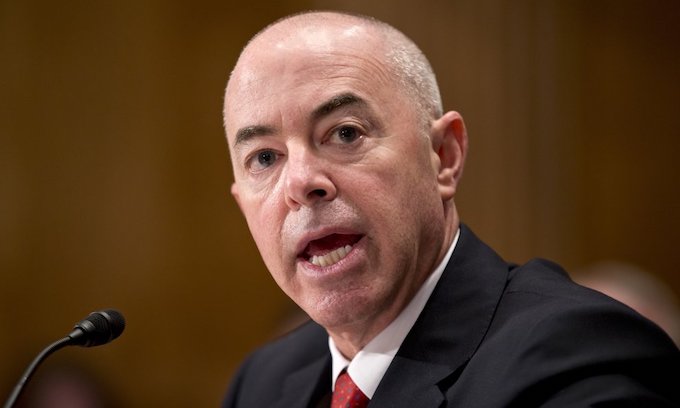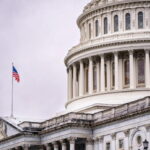The Biden administration has unveiled a series of measures aimed at curbing an anticipated surge in migrant arrivals at the U.S. southern border when a COVID-19-era health policy that barred entry to millions expires in less than two weeks.
The measures were unveiled Thursday during a joint press conference of the Departments of State and Homeland Security in Washington, D.C., ahead of Title 42’s expiration on May 11.
Instituted in March of 2020 by the Centers for Disease Control and Prevention under the previous Trump administration, Title 42 has been used as of last month to rapidly expel more than 2.8 million migrants and asylum seekers, according to U.S. Customs and Border Protection data.
After its expiration, the Biden administration will return to processing all migrants under Title 8 immigration authorities of the U.S. code, and officials are warning those who may attempt the dangerous journey north that this does not mean they will be allowed to enter the United States.
“We do expect that encounters at our southern border will [be] increasing, as smugglers are seeking to take advantage of this change and already are hard at work spreading disinformation that the border will be open after that,” Homeland Security Secretary Alejandro Mayorkas told reporters in a press conference.
However, he added that they have been “preparing for this transition for more than a year and a half.”
Mayorkas was quick to warn that unlike Title 42, which permits immediate removals, those migrants processed under Title 8 who are found inadmissible due to irregular immigration face stiffer consequences, such as a five-year re-entry ban and potential criminal prosecution for repeated attempts to cross the border.
“The return to processing migrants under Title 8 authorities will be swift and immediate,” he said.
“Let me be clear: Our border is not open and will not be open after May 11th.”
In anticipation of the surge, the Biden administration official unveiled measures that include creating additional pathways for legal entry to the United States and stricter consequences for failure to use them.
The biggest change announced Thursday is the creation of so-called Regional Processing Centers that will be erected within the borders of Western Hemisphere partners, including Guatemala, El Salvador, Honduras and Colombia.
“The United States will use Regional Processing Centers to expedite prescreening of individuals for lawful pathways to the United States,” a senior Biden administration official told reporters during a background call on the Thursday announcement.
The centers will screen migrants and those eligible will be referred for refugee resettlement or other lawful pathways, including parole programs, to enter the United States, while also providing information on “local options,” the official said, adding that Canada and Spain have also shown interest in accepting referrals from the processing centers.
Mayorkas described the centers during the press conference as an attempt to cut smugglers out of the immigration process, which he said is important as they have witnessed a rise in smuggling organizations over the last decade.
“The whole model is to reach the people where they are, to cut the smugglers out and to have them avoid the perilous journey that too many do not make,” he said.
To work in conjunction with that mission, Panama, Colombia and the United States launched a 60-day law enforcement campaign on April 20 to disrupt criminal smuggling networks.
The United States will also be increasing the removals of those who do not have a lawful reason to be in the country. According to U.S. officials, migrants who cross the border without authorization and who fail to secure protection should expect to face a five-year entry ban.
Among the entry pathways created Thursday include a new family reunification parole process for El Salvador, Guatemala, Honduras and Colombia as well as the doubling of the number of refugees to be accepted in the United States from Western Hemisphere countries.
“We are building lawful pathways for people to come to the United States without resorting to the smugglers,” Mayorkas said. “At the same time, we are imposing consequences on those who do not use those pathways and instead irregularly migrate to our southern border.”
The announcement comes as the Biden administration has been dogged by Republican criticism over migrants attempting the enter the country via the southern border. It has also received criticism from immigration and human rights advocates over efforts to keep Title 42 in place, with its expiration being court-ordered.
It also comes after the White House in late February proposed a new immigration rule that will assume inadmissible any migrant who attempts to enter the United States irregularly.
Human Rights First on Thursday said it welcomes the Biden administration’s plans for expanded resettlement and family reunification parol while calling on it to abandon the planned rule it called an asylum ban.
“The Biden administration is rightly expanding refugee resettlement from the Americas, an overdue step towards addressing a long-standing gap for people in need of international protection,” Eleanor Acer, senior director of refugee protection at Human Rights First, said in a statement.
“This initiative should swiftly bring refugees to safety and not be used to reduce the resettlement of refugees from other regions. The Biden administration should focus on measures like increasing refugee resettlement and regular pathways and abandon its plan to impose an asylum ban that would be a legal, moral and political mistake.”
—-
This content is published through a licensing agreement with Acquire Media using its NewsEdge technology.



















“Mayorkas was quick to warn that unlike Title 42, which permits immediate removals, those migrants processed under Title 8 who are found inadmissible due to irregular immigration face stiffer consequences, such as a five-year re-entry ban and potential criminal prosecution for repeated attempts to cross the border.”
“The return to processing migrants under Title 8 authorities will be swift and immediate,” he said.
Hummm…… an illegal immigrant, illegally enters the U.S. and this Alejandro Mayorkas United States Secretary of Homeland Security says the Biden administration will give them a five-year re-entry ban, if they continue to ignore our immigration laws and continue to illegally enter the U.S..
What gives these Democrat Fools the idea that the illegal immigrant criminals wont ignore the five-year re-entry ban???
This traitorous, incompetent Biden administration is diverse, but totally incompetent in everything! 🙁 🙁 🙁
2 thing that to change is no public Assistance for anyone illegal. Then it’s against the law to ask someone on a job Application their Citizenship status. But it’s illegal to hire an illegal. You cannot ask citizenship for lot of things ?? Job , rent ,public Assistance, housing , healthcare. That needs to stop.
Bet all these illegal invaders will be “grandfathered” against the new ruling and will be allowed to just walk in a start getting thousands in aid.
Why does the government not be bold and straight up tell all these illegal invaders to return to one of the processing centers in theor own country or neighboring country.
To work in conjunction with that mission, Panama, Colombia and the United States launched a 60-day law enforcement campaign on April 20 to disrupt criminal smuggling networks.
Sure close the barn door after the cattle got out.
BECAUSE they don’t want to stop the invasion. IN FACT they are doing all they can to ENCOURAGE IT!